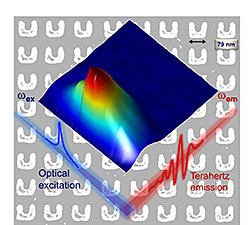- Number 406 |
- February 3, 2014
Broadband THz wave generation with metamaterials demo'd

A team led by Ames Laboratory physicists
demonstrated broadband, gapless
terahertz emission (red line) from split-ring
resonator metamaterials (background) in
the telecomm wavelength. The THz
emission spectra exhibit significant
enhancement at magnetic-dipole resonance
of the metamaterials emitter (shown in
inset image). This approach has potential
to generate gapless spectrum covering the
entire THz band, which is key to
developing practical THz technologies and
to exploring fundamental understanding
of optics.
Scientists at DOE's Ames Laboratory have demonstrated broadband terahertz (THz) wave generation using metamaterials. The discovery may help develop noninvasive imaging and sensing, and make possible THz-speed information communication, processing and storage.
The team created a metamaterial made up of a special type of meta-atom called split-ring resonators. Split-ring resonators, because of their u-shaped design, display a strong magnetic response to any desired frequency waves in the THz to infrared spectrum. They demonstrated their technique using the wavelength used by telecommunications (1.5 microns), but the THz generation can be tailored simply by tuning the size of the meta-atoms in the metamaterial.
[Breehan Gerleman Lucchesi, 515.294.9750,
breehan@ameslab.gov]
